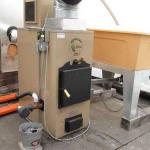Energy
Checklist: Energy Conservation
New greenhouse designs, better glazing, improved heating and ventilating equipment and new management systems should be included when upgrading or adding on. With typical annual energy usage being 75% for heating, 15% for electricity, and 10% for vehicles, efforts and resources should be put where the greatest savings can be realized. Prices are at the time of publication.
Reduce Air Leaks
- Keep doors closed - use door closer or springs.
- Weather-strip doors, vents, and fan openings. For example, a 48-inch fan louver that fails to close properly leaving 1-inch gaps, allows 23,000 Btu/hr of heat to escape, costing $0.53 if you are burning $2.30 fuel oil (prices at time of publication).
- Lubricate louvers frequently so that they close tightly. A partially open louver may allow several air changes per hour. Additional fuel is needed to heat this air. Shut off some fans during the winter and cover openings with insulation or plastic to reduce infiltration of air.
- Repair broken glass or holes in the plastic covering.
Double Covering
- Line sidewalls and endwalls of greenhouse inside with poly or bubble wrap to achieve the thermopane effect. Install double wall polycarbonate structured sheets to get insulation effect and reduce recovering labor.
- Use poly with an infrared inhibitor on the inner layer for 15% savings. Payback is two to three months.
- Add a single or double layer of plastic over older glasshouses to reduce infiltration and heat loss by 50%.
Energy Conserving Blanket or Curtain
Foundation and Sidewall Insulation
- Insulate the foundation. Place 1- to 2-inch polyurethane or polystyrene board to 18 inches below ground to reduce heat loss. This can increase the soil temperature near the sidewall as much as 10 °F during the winter.
- Insulate the kneewall or sidewall to bench height. Use 1- to 2-inch insulation board. Applying 2 inches of foam insulation to a 3-foot-high kneewall on a 28-foot by 100-foot greenhouse will save about 400 gallons of fuel oil per year.
- Insulate behind sidewall heat pipes. Use aluminum faced building paper or insulation board behind to radiant heat back into the growing area. Leave air space next to wall to prevent frost damage to the wall.
Site Location
- Locate new greenhouses in sheltered areas to reduce wind-induced heat loss, if this does not reduce light.
- Install windbreaks on the north and northwest sides of the greenhouse. The windbreak can be a double row of conifer trees or plastic snow fence.
Space Utilization
- Increase space utilization to 80 to 90% with peninsular or movable benches.
- Install multi-level racks for crops that don't require high light levels.
- Grow a crop of hanging baskets on overhead rails or truss-mounted conveyor system.
- Roll-out bench system can double growing space. Plants are moved outside during the day.
Efficient Heating System
- Installation of floor or under-bench heat will allow air temperature to be set 5 to 10 ºF lower.
- Yearly maintenance - Check boiler, burner and backup systems to make sure they are operating at peak efficiency. Have furnaces cleaned and adjusted and an efficiency test run before heating season. A 2% increase in efficiency for a 30-foot by 150-foot greenhouse will save about 200 gallons of fuel oil.
- Clean heating pipes and other radiation surfaces frequently.
- Check accuracy of thermostats - correcting a reading that is 2 ºF high will save $100 to $200.
- Install electronic thermostats or controllers with a 1 °F accuracy. Potential yearly savings of 500 gallons of fuel oil in a 30 foot by 100 foot greenhouse when changing from a mechanical to electronic thermostat or controller.
- Aspirate thermostats or sensors for more uniform temperature control. Differential between on and off can be reduced as much as 6 ºF.
- Install horizontal air flow (HAF) fans to get more uniform temperature in growing area.
- Insulate distribution pipes in areas where heat is not required.
- Check and repair leaks in valves, steam traps, and pipes.
Efficient Cooling System
- Use shading to reduce the need for mechanical cooling.
- Build a new greenhouse with open-roof design to eliminate the need for fans.
- Install roll-up or guillotine sides to reduce the need for fan ventilation.
- Install evaporative cooling to get better temperature control during the summer.
- Select fans that meet AMCA standards and have a Ventilation Efficiency Ratio greater than 15.
- Use the largest diameter fan with the smallest motor that meets ventilation requirements.
- Keep doors closed when fans are operating. Locate intake louvers to give uniform cooling.
Conserve Electricity
- Have wiring system inspected for overloading, corroded parts, and faulty insulation.
- Replace 3 hp or larger motors with high efficiency ones to reduce electric consumption by 2 to 5%.
- Check for proper belt tension and alignment.
- Replace incandescent bulbs with low wattage fluorescent or HID bulbs. Save two-thirds on electricity.
- Install motion detectors to control security lights so they are not on all the time.
Trucks and Tractors
- Regularly scheduled tune-ups can save 10% on fuel usage. Keep tires properly inflated.
- Avoid lengthy idling. Idling can consume 15 to 20% of the fuel used.
- Run equipment in the proper gear for the load.
Water Systems
- Locate hot water tanks as close as possible to the largest and most frequent use. Insulate pipes.
- Heat water to the lowest temperature needed; usually 120 ºF is adequate.
- Use pipe size large enough to supply necessary water at minimum friction loss.
- Eliminate water leaks. A dripping faucet at 60 drops per minute will waste 113 gallons per month.
Management
- Lower night temperature. Fuel consumption is reduced 3% for each 1 ºF night temperature is lowered.
- Delay starting the greenhouse by a week or more. Build a germination/growth chamber to start seedlings.
- Keep growing areas full at all times.
- Use root zone heating.
Energy Resources
Booklet: “Energy Conservation for Commercial Greenhouses” - NRAES-3, 100 pages, $21.25 available from the Resource Center, Unit 4035, W.B. Young Building, Rm.2, Storrs, CT 06269-4035. Make check payable to UConn. Price includes postage and handling.
Fact Sheets: For details on energy use in greenhouses see the following Greenhouse Crops & Floriculture Program Energy fact sheets available from University of Massachusetts Extension
- Corn - A Home Grown Heat Source
- Insulation-Know How
- Natural Ventilation in Hoophouses
- Combat Higher Fuel Prices with Efficient Heating Systems
- High Tunnels - Low Cost Seasonal Growing Space
- Greenhouse Energy Conservation Checklist
- Fuels and Alternate Heat Sources for Commercial Greenhouses
- Horizontal Air Flow is Best for Greenhouse Air Circulation
- Mechanization and Labor Saving for the Small Grower
- Retractable Roof Greenhouses and Shadehouses
- Root Zone Heating Systems
- Selecting and Building a Commercial Greenhouse
- Selecting an Energy/Shade Screen System
- Selecting and Maintaining Thermostats
- Will the Zoning Commission Approve Your Greenhouse?
- Greenhouse Ventilation
- Greenhouse Facilities Master Plan
- Problems With Using Unvented Heaters in Greenhouses
- Geothermal Heat for Greenhouses
- Wood Heat for Greenhouses
Massachusetts Department of Agricultural Resources
The MDAR Energy Program’s primary function is to promote energy knowledge and awareness and to facilitate the implementation of energy related projects for our agri-businesses through energy efficiency, energy conservation, and renewable energy applications, as a means to reduce both energy costs and environmental pollution. Information on grants and funding are also available on this website.
Energy Broker/Consultant
Large energy users often hire a consultant or broker to assist in reducing and managing their electricity and natural gas, fuel oil and other energy expenses. The consultant analyzes business energy use and helps negotiate contracts and rates.
Compare Fuel Efficiency
Consider the cost of different fuels in terms of energy value.
To determine the cost and value of a fuel, first consider the number of British Thermal Units (Btu) produced by the fuel (Table 1). To determine the Btu value per dollar, divide the fuel's Btu per unit by the unit price. Example: #2 Fuel Oil BTU/$ = 138,500 BTU/gal = 55,400 BTU/dollar
$2.50/gal
| Fuel type | Heating value | |
|---|---|---|
| Natural Gas | 1,030 Btu/cu ft | 100,000 Btu/therm |
| Propane | 2,500 Btu/cu ft | 92,500 Btu/gal |
| Methane | 1,000 Btu/cu ft | |
| Landfill gas | 500 Btu/cu ft | |
| Butane | 3,200 Btu/cu ft | 130,000 Btu/gal |
| Methanol | 57,000 Btu/gal | |
| Ethanol | 76,000 Btu/gal | |
| Fuel Oil | ||
| Kerosene | 135,000 Btu/gal | |
| #2 | 138,500 Btu/gal | |
| #4 | 145,000 Btu/gal | |
| #6 | 153,000 Btu/gal | |
| 1 Barrel of oil = 42 gallons | ||
| Waste oil | 125,000 Btu/gal | |
| Biodiesel - Waste vegetable oil | 120,000 Btu/gal | |
| Gasoline | 125,000 Btu/gal | |
| Wood | ||
| Softwood | 2-3,000 lb/cord | 10-15,000,000 Btu/cord |
| Hardwood | 4-5,000 lb/cord | 18-24,000,000 Btu/cord |
| Sawdust - green | 10-13 lb/cu ft | 8-10,000,000 Btu/ton |
| Sawdust - kiln dry | 8-10 lb/cu ft | 14-18,000,000 Btu/ton |
| Chips - 45% moisture | 10-30 lb/cu ft | 7,600,000 Btu/ton |
| Hogged | 10-30 lb/cu ft | 16-20,000,000 Btu/ton |
| Bark | 10-20 lb/cu ft | 9-10,500,000 Btu/ton |
| Wood pellets - 10% moisture | 40-50 lb/cu ft | 16,000,000 Btu/ton |
| Hard Coal (anthracite) | 13,000 Btu/lb | 26,000,000 Btu/ton |
| Soft Coal (bituminous) | 12,000 Btu/lb | 24,000,000 Btu/ton |
| Rubber - pelletized | 16,000 Btu/lb | 32-34,000,000 Btu/ton |
| Plastic | 18-20,000 Btu/lb | |
| Corn - shelled | 7,800-8,500 Btu/lb | 15-17,000,000 Btu/ton |
| cobs | 8,000-8,300 Btu/lb | 16-17,000,000 Btu/ton |
| Electricity | 3412 Btu/kilowatt hour | |
University of Connecticut, Storrs CT 06269-4087
December 2004




